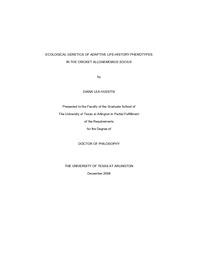| dc.description.abstract | As many organisms inhabit unstable environments, the ability to respond to changing environmental conditions is highly adaptive, and results in the evolution of phenotypic plasticity. Thus, identifying the genetic basis and evolutionary origins of adaptive life-history phenotypes, such as phenotypic plasticity, is an active and important research area within the field of evolutionary biology. In the last two decades, gene-expression techniques have been developed which allow genes to be identified and gene-expression levels measured in a range of species, reducing dependence on classic genetic model systems and allowing an array of species with interesting ecological phenotypes to be used as models to study the evolution of adaptive traits.Here, I first provide an overview of gene-expression techniques, both classic and more modern, which can be used to identify genes and their expression levels in a range of species, including both classical genetic model systems and any species of interest. This chapter provides details of the use and specific applications for many common (and some less common) gene-expression techniques, provides information about the specific laboratory methodology used to perform each technique, whether a given technique can be used in any system or is restricted to genetic model systems, and finally what follow-up experiments are needed to confirm differential gene expression. This chapter is intended to be a resource for any biologist interested in learning more about what gene-expression techniques may be useful in their particular system to address a given biological question.Second, I use one of these gene-expression techniques, suppression subtractive hybridization (SSH), to identify gene-expression differences between developmental phenotypes in the cricket Allonemobius socius. Specifically, I looked at expression differences between diapausing and direct-developing embryos. The ability to break diapause in response to changing environmental conditions is an adaptive trait, yet little is known about its genetic basis in egg-diapausing species. Several genes were identified as being upregulated in eggs which had broken diapause, relative to their diapausing counterparts, and other genes were identified as expressed in diapausing eggs but not in direct-developing eggs.Next, I explore population-level variation in the plasticity of the diapause response within twelve geographically-diverse populations of A. socius. I also use the amplified fragment-length polymorphism (AFLP) technique to look for genetic correlates of mean diapause frequency and plasticity among these twelve populations. I found significant variation within and among populations for both mean and plasticity of diapause. Additionally, different components of genetic variance appear to underlie the mean and plasticity of the diapause response, indicating that these two components may be able to evolve independently in this species.Finally, I explore the possible evolutionary origins of a cline in allele frequencies at the isocitrate dehydrogenase-1 (Idh-1) locus in A. socius. Differences in enzyme kinetic performance appear to underlie the natural geographic distributions of two alleles at this locus, indicating that natural selection may have shaped the distribution of Idh-1 alleles in this species. This chapter serves as a case-study for the type of additional follow-up experiments which can be performed once a gene of interest associated with a particular adaptive phenotype is identified using a combination of phenotypic screens and genetic techniques. | en_US |

